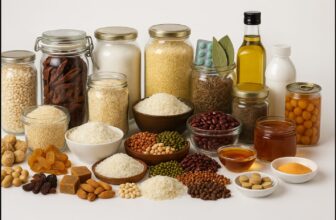Magnesium is a mineral your body can’t live without, yet most people in India have no idea they’re low on it. It supports over 300 crucial functions in your body, from muscle movement and sleep to energy production and heart rhythm.
But here’s the problem: modern Indian diets often lack enough magnesium, and filtered water, processed foods, polished grains, and chronic stress make it worse. Symptoms show up slowly, so it’s easy to miss, or misdiagnose.
If you’re constantly tired, moody, or dealing with random cramps or poor sleep, this list could help you spot the root cause.
How Magnesium Deficiency Happens in India
- Overconsumption of refined rice, flour, and sugar
- Low intake of green leafy vegetables, seeds, and millets
- High tea/coffee consumption, which may interfere with absorption
- Widespread use of RO water, which removes essential minerals
- Lifestyle stress, which increases magnesium excretion
- Medications like antacids, proton-pump inhibitors, or diuretics
- Chronic conditions like diabetes, PCOS, IBS, or thyroid issues
15 Signs You’re Low on Magnesium
1. Muscle Cramps or Twitching
Nighttime leg cramps or eyelid twitching are classic signs. You might feel stiff or sore after basic activity.
2. Constant, Unexplained Fatigue
Feeling exhausted despite enough sleep? Magnesium supports energy production at the cellular level. Without it, your body can’t recharge.
3. Anxiety or Feeling “On Edge”
Magnesium plays a role in regulating your nervous system. Deficiency may trigger restlessness, racing thoughts, or a constant sense of pressure.
4. Poor Sleep Quality
You toss, turn, or wake up multiple times. Magnesium helps calm your nervous system and regulates melatonin.
5. Frequent Headaches or Migraines
Recurring headaches may be due to blood vessel tension or nerve overstimulation, both linked to low magnesium.
6. Irregular Heartbeats or Palpitations
Your heart relies on magnesium for proper rhythm and relaxation. Skipped beats or fluttering could be a sign.
7. Constipation or Slow Digestion
Magnesium relaxes intestinal muscles and attracts water into the gut. Without it, bowel movements slow down.
8. Painful Periods or PMS Symptoms
Increased cramps, mood swings, or bloating before your cycle could be related to low magnesium levels.
9. Tingling or Numbness in Hands/Feet
Magnesium is involved in nerve signal transmission. Deficiency can cause tingling or pins-and-needles sensations.
10. High Blood Pressure (Even in Youth)
Magnesium helps relax blood vessels. Without enough, you may develop elevated blood pressure early on.
11. Bone Aches or Osteopenia Signs
You need magnesium to absorb calcium into your bones. Low levels weaken your skeletal system over time.
12. Sugar or Chocolate Cravings
Your body may crave magnesium-rich foods like jaggery, chocolate, or sweets without realizing it’s a nutrient signal.
13. Low Vitamin D Despite Sun Exposure
Magnesium activates vitamin D. If your levels stay low even after supplements or sunshine, check your magnesium.
14. Slow Recovery After Workouts
Unusual soreness, stiffness, or breathlessness after mild exercise may reflect poor magnesium levels.
15. Trouble Focusing or Mental Fog
Low magnesium disrupts brain chemistry and makes it harder to concentrate, especially under stress or screen fatigue.
Magnesium Deficiency: What to Eat Every Day?
Start with Your Diet: Magnesium-Rich Foods in India
These are accessible, affordable, and familiar in most Indian households:
- Green leafy vegetables: Palak, methi, drumstick leaves
- Nuts & seeds: Peanuts, almonds, pumpkin seeds, sesame (til)
- Legumes: Moong, chana, rajma, masoor dal
- Millets: Ragi, bajra, jowar
- Whole grains: Brown rice, wheat roti (avoid maida)
- Fruits: Bananas, dried figs
- Coconut water: Natural mineral booster
RO Water Tips
- RO water lacks minerals, consider adding a mineral cartridge or blending with unfiltered boiled water occasionally.
Cooking Tips
- Don’t overboil vegetables. Light steaming preserves minerals.
- Soak dals and seeds to reduce anti-nutrients and improve absorption.
Safe Magnesium Supplement Options in India
- Forms to look for: Magnesium glycinate or citrate (better absorbed, gentle on stomach)
- Avoid magnesium oxide, poorly absorbed, may cause loose motion
- Can be taken after dinner to improve sleep and muscle relaxation
- Speak to a doctor before use if you have kidney issues or are on medications
Consult Your Physician, If:
- Persistent symptoms even after diet changes
- If you’re on long-term medications (antacids, diuretics, metformin)
- If you have diabetes, PCOS, IBS, or thyroid conditions
- Remember: blood tests often don’t detect intracellular magnesium depletion, symptoms are your best clue
Summary: The Hidden Mineral Deficiency Silently Affecting Millions in India
Magnesium deficiency is a low-awareness, high-impact issue in India. It doesn’t cause sudden breakdowns, it wears you down slowly. But the fix is simple: whole food, traditional ingredients, conscious habits.
You don’t need imported supplements or exotic superfoods. You need knowledge, and consistency.
If you’ve been ignoring your tiredness, mood swings, cramps, or restless nights, this is your signal to take it seriously.





